MGT602 Business Decision Analytics: In-Depth Research Analysis
VerifiedAdded on 2023/05/30
|14
|3001
|60
Report
AI Summary
This report examines the use of unstructured information in business decision analytics, focusing on tacit knowledge and Leximancer analysis. It analyzes email exchanges among R&D staff to identify communication patterns and clusters, and uses Leximancer to assess communication between management, customers, and field service teams. The analysis reveals insights into the effectiveness of communication channels, support availability, and the role of management in decision-making. Recommendations are provided to improve customer engagement, empower field service teams, and enhance support strategies. The report concludes with suggestions for leveraging these insights to improve organizational performance, emphasizing the importance of open communication and strategic decision-making. Desklib provides similar solved assignments and past papers for students.
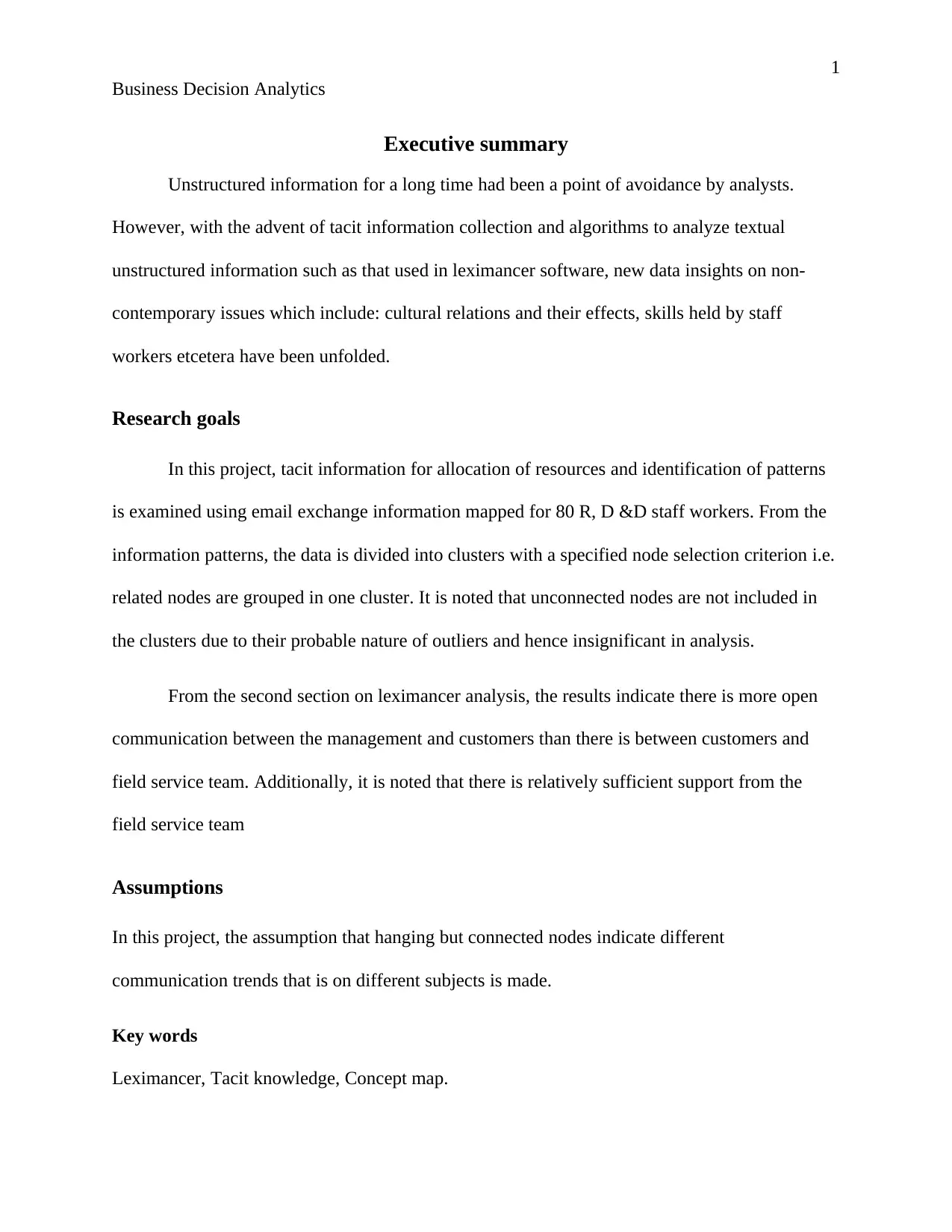
1
Business Decision Analytics
Executive summary
Unstructured information for a long time had been a point of avoidance by analysts.
However, with the advent of tacit information collection and algorithms to analyze textual
unstructured information such as that used in leximancer software, new data insights on non-
contemporary issues which include: cultural relations and their effects, skills held by staff
workers etcetera have been unfolded.
Research goals
In this project, tacit information for allocation of resources and identification of patterns
is examined using email exchange information mapped for 80 R, D &D staff workers. From the
information patterns, the data is divided into clusters with a specified node selection criterion i.e.
related nodes are grouped in one cluster. It is noted that unconnected nodes are not included in
the clusters due to their probable nature of outliers and hence insignificant in analysis.
From the second section on leximancer analysis, the results indicate there is more open
communication between the management and customers than there is between customers and
field service team. Additionally, it is noted that there is relatively sufficient support from the
field service team
Assumptions
In this project, the assumption that hanging but connected nodes indicate different
communication trends that is on different subjects is made.
Key words
Leximancer, Tacit knowledge, Concept map.
Business Decision Analytics
Executive summary
Unstructured information for a long time had been a point of avoidance by analysts.
However, with the advent of tacit information collection and algorithms to analyze textual
unstructured information such as that used in leximancer software, new data insights on non-
contemporary issues which include: cultural relations and their effects, skills held by staff
workers etcetera have been unfolded.
Research goals
In this project, tacit information for allocation of resources and identification of patterns
is examined using email exchange information mapped for 80 R, D &D staff workers. From the
information patterns, the data is divided into clusters with a specified node selection criterion i.e.
related nodes are grouped in one cluster. It is noted that unconnected nodes are not included in
the clusters due to their probable nature of outliers and hence insignificant in analysis.
From the second section on leximancer analysis, the results indicate there is more open
communication between the management and customers than there is between customers and
field service team. Additionally, it is noted that there is relatively sufficient support from the
field service team
Assumptions
In this project, the assumption that hanging but connected nodes indicate different
communication trends that is on different subjects is made.
Key words
Leximancer, Tacit knowledge, Concept map.
Paraphrase This Document
Need a fresh take? Get an instant paraphrase of this document with our AI Paraphraser
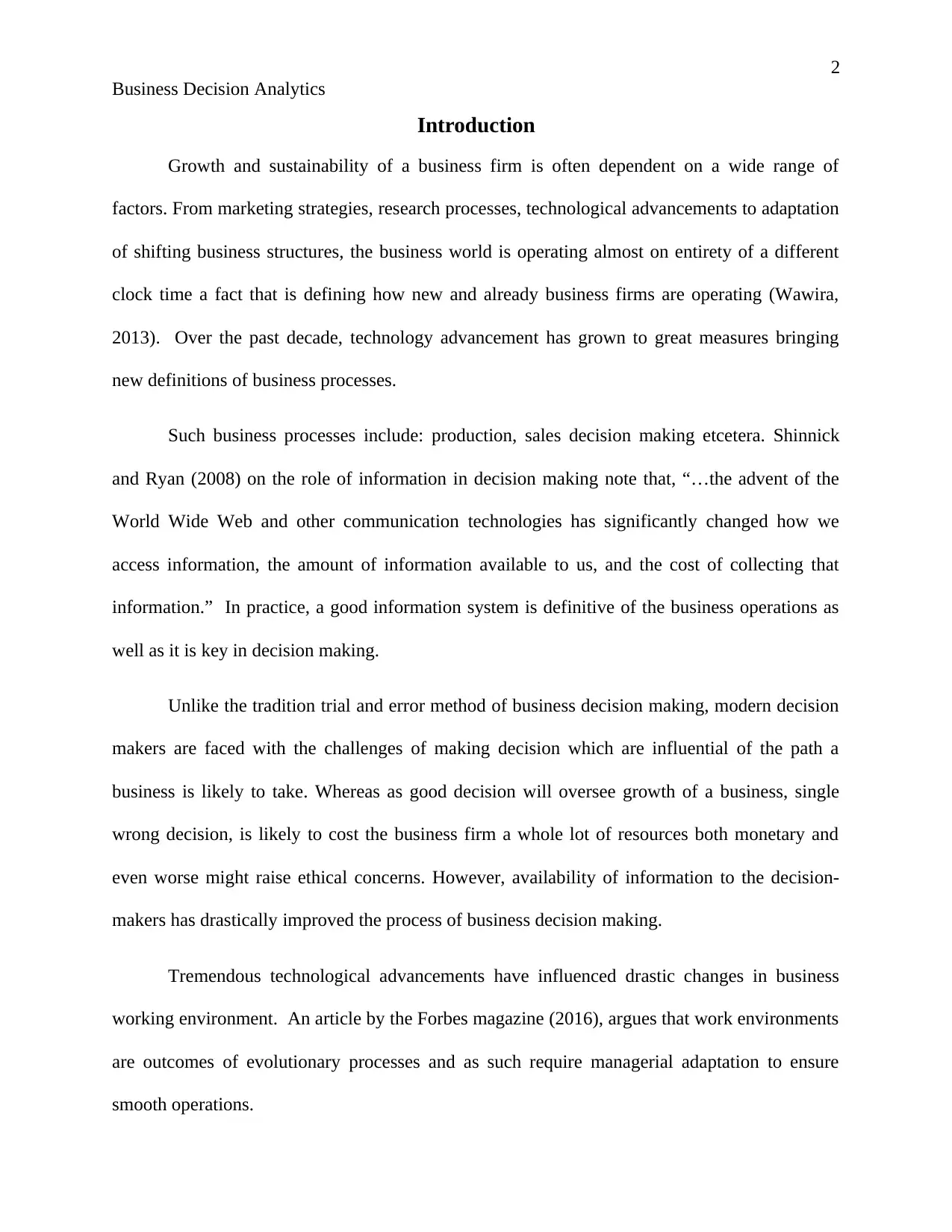
2
Business Decision Analytics
Introduction
Growth and sustainability of a business firm is often dependent on a wide range of
factors. From marketing strategies, research processes, technological advancements to adaptation
of shifting business structures, the business world is operating almost on entirety of a different
clock time a fact that is defining how new and already business firms are operating (Wawira,
2013). Over the past decade, technology advancement has grown to great measures bringing
new definitions of business processes.
Such business processes include: production, sales decision making etcetera. Shinnick
and Ryan (2008) on the role of information in decision making note that, “…the advent of the
World Wide Web and other communication technologies has significantly changed how we
access information, the amount of information available to us, and the cost of collecting that
information.” In practice, a good information system is definitive of the business operations as
well as it is key in decision making.
Unlike the tradition trial and error method of business decision making, modern decision
makers are faced with the challenges of making decision which are influential of the path a
business is likely to take. Whereas as good decision will oversee growth of a business, single
wrong decision, is likely to cost the business firm a whole lot of resources both monetary and
even worse might raise ethical concerns. However, availability of information to the decision-
makers has drastically improved the process of business decision making.
Tremendous technological advancements have influenced drastic changes in business
working environment. An article by the Forbes magazine (2016), argues that work environments
are outcomes of evolutionary processes and as such require managerial adaptation to ensure
smooth operations.
Business Decision Analytics
Introduction
Growth and sustainability of a business firm is often dependent on a wide range of
factors. From marketing strategies, research processes, technological advancements to adaptation
of shifting business structures, the business world is operating almost on entirety of a different
clock time a fact that is defining how new and already business firms are operating (Wawira,
2013). Over the past decade, technology advancement has grown to great measures bringing
new definitions of business processes.
Such business processes include: production, sales decision making etcetera. Shinnick
and Ryan (2008) on the role of information in decision making note that, “…the advent of the
World Wide Web and other communication technologies has significantly changed how we
access information, the amount of information available to us, and the cost of collecting that
information.” In practice, a good information system is definitive of the business operations as
well as it is key in decision making.
Unlike the tradition trial and error method of business decision making, modern decision
makers are faced with the challenges of making decision which are influential of the path a
business is likely to take. Whereas as good decision will oversee growth of a business, single
wrong decision, is likely to cost the business firm a whole lot of resources both monetary and
even worse might raise ethical concerns. However, availability of information to the decision-
makers has drastically improved the process of business decision making.
Tremendous technological advancements have influenced drastic changes in business
working environment. An article by the Forbes magazine (2016), argues that work environments
are outcomes of evolutionary processes and as such require managerial adaptation to ensure
smooth operations.
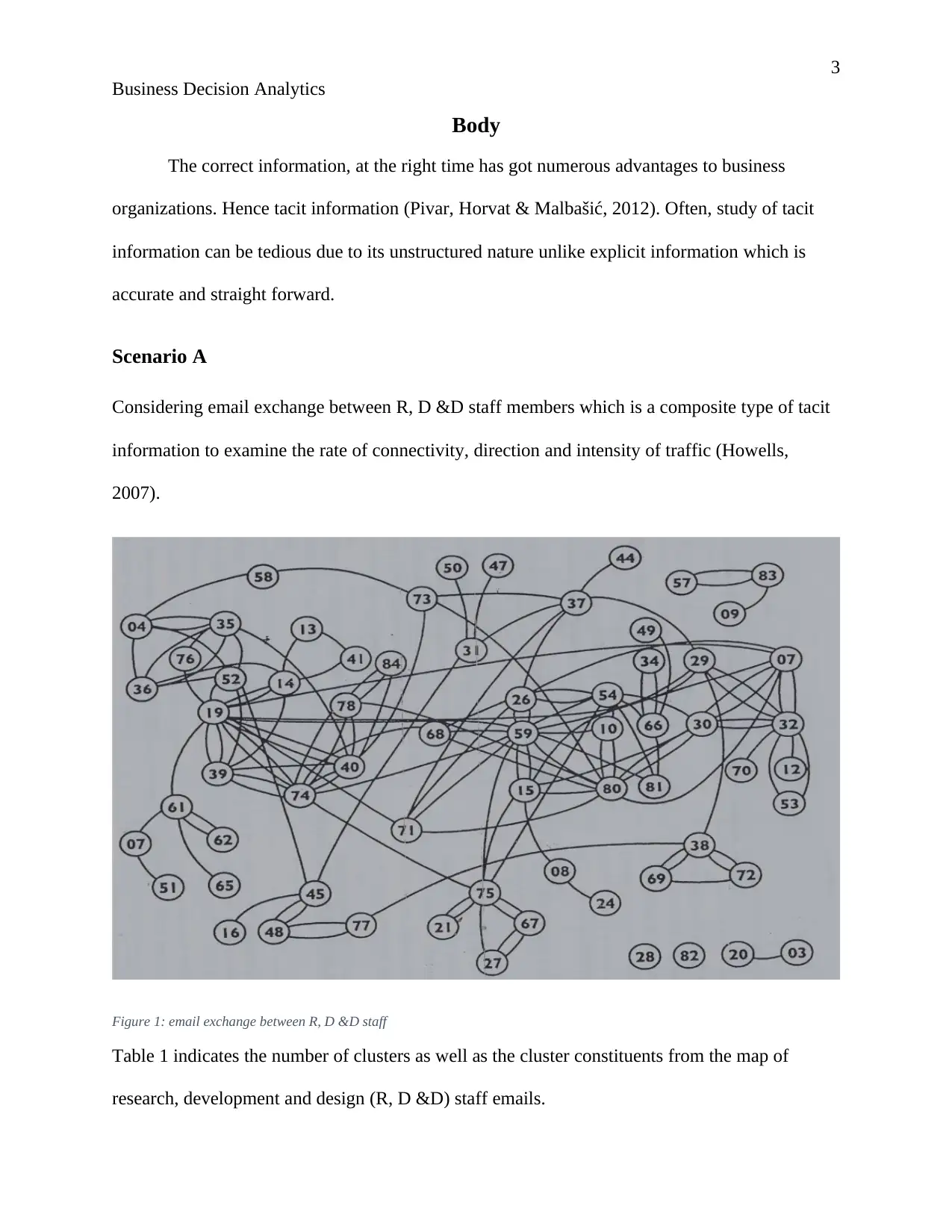
3
Business Decision Analytics
Body
The correct information, at the right time has got numerous advantages to business
organizations. Hence tacit information (Pivar, Horvat & Malbašić, 2012). Often, study of tacit
information can be tedious due to its unstructured nature unlike explicit information which is
accurate and straight forward.
Scenario A
Considering email exchange between R, D &D staff members which is a composite type of tacit
information to examine the rate of connectivity, direction and intensity of traffic (Howells,
2007).
Figure 1: email exchange between R, D &D staff
Table 1 indicates the number of clusters as well as the cluster constituents from the map of
research, development and design (R, D &D) staff emails.
Business Decision Analytics
Body
The correct information, at the right time has got numerous advantages to business
organizations. Hence tacit information (Pivar, Horvat & Malbašić, 2012). Often, study of tacit
information can be tedious due to its unstructured nature unlike explicit information which is
accurate and straight forward.
Scenario A
Considering email exchange between R, D &D staff members which is a composite type of tacit
information to examine the rate of connectivity, direction and intensity of traffic (Howells,
2007).
Figure 1: email exchange between R, D &D staff
Table 1 indicates the number of clusters as well as the cluster constituents from the map of
research, development and design (R, D &D) staff emails.
⊘ This is a preview!⊘
Do you want full access?
Subscribe today to unlock all pages.

Trusted by 1+ million students worldwide
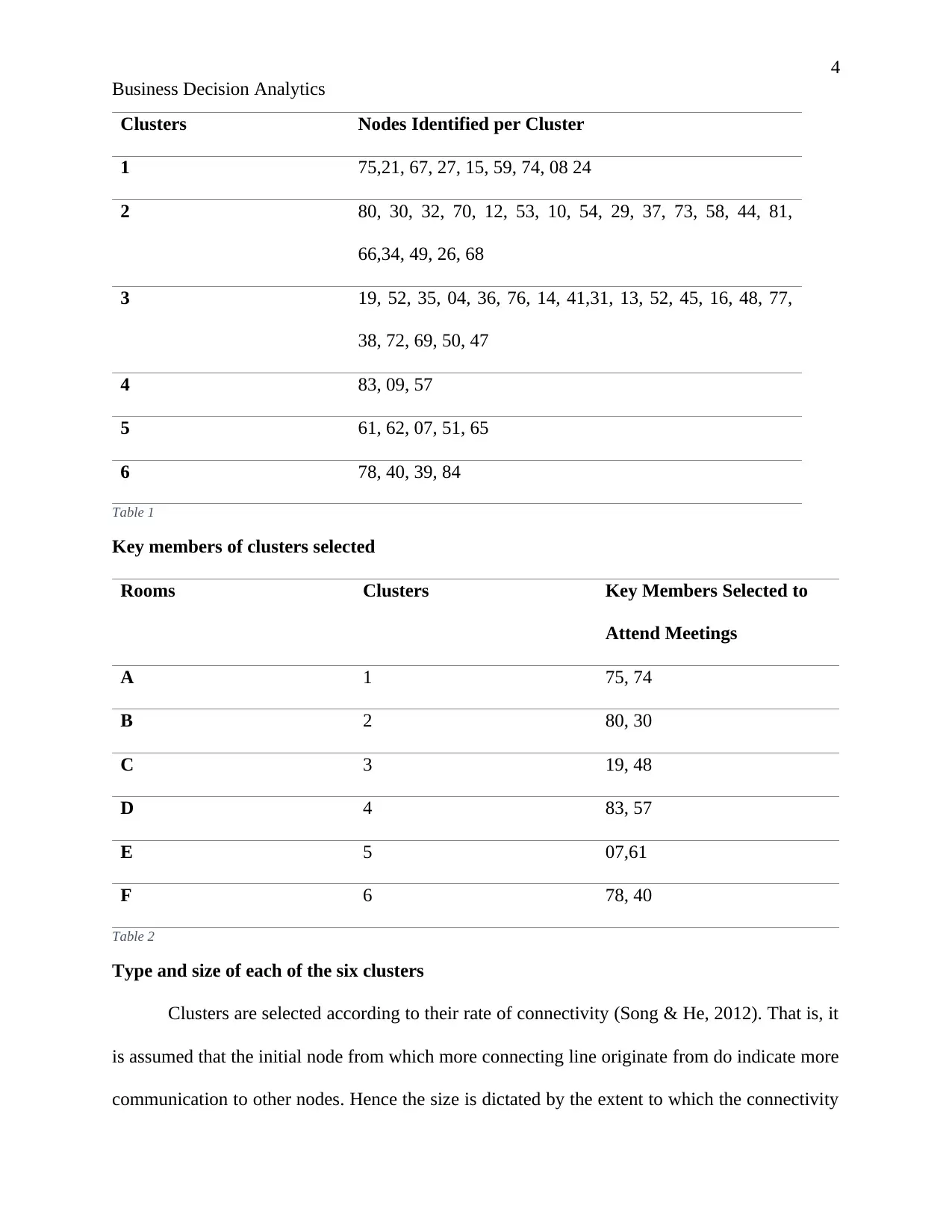
4
Business Decision Analytics
Clusters Nodes Identified per Cluster
1 75,21, 67, 27, 15, 59, 74, 08 24
2 80, 30, 32, 70, 12, 53, 10, 54, 29, 37, 73, 58, 44, 81,
66,34, 49, 26, 68
3 19, 52, 35, 04, 36, 76, 14, 41,31, 13, 52, 45, 16, 48, 77,
38, 72, 69, 50, 47
4 83, 09, 57
5 61, 62, 07, 51, 65
6 78, 40, 39, 84
Table 1
Key members of clusters selected
Rooms Clusters Key Members Selected to
Attend Meetings
A 1 75, 74
B 2 80, 30
C 3 19, 48
D 4 83, 57
E 5 07,61
F 6 78, 40
Table 2
Type and size of each of the six clusters
Clusters are selected according to their rate of connectivity (Song & He, 2012). That is, it
is assumed that the initial node from which more connecting line originate from do indicate more
communication to other nodes. Hence the size is dictated by the extent to which the connectivity
Business Decision Analytics
Clusters Nodes Identified per Cluster
1 75,21, 67, 27, 15, 59, 74, 08 24
2 80, 30, 32, 70, 12, 53, 10, 54, 29, 37, 73, 58, 44, 81,
66,34, 49, 26, 68
3 19, 52, 35, 04, 36, 76, 14, 41,31, 13, 52, 45, 16, 48, 77,
38, 72, 69, 50, 47
4 83, 09, 57
5 61, 62, 07, 51, 65
6 78, 40, 39, 84
Table 1
Key members of clusters selected
Rooms Clusters Key Members Selected to
Attend Meetings
A 1 75, 74
B 2 80, 30
C 3 19, 48
D 4 83, 57
E 5 07,61
F 6 78, 40
Table 2
Type and size of each of the six clusters
Clusters are selected according to their rate of connectivity (Song & He, 2012). That is, it
is assumed that the initial node from which more connecting line originate from do indicate more
communication to other nodes. Hence the size is dictated by the extent to which the connectivity
Paraphrase This Document
Need a fresh take? Get an instant paraphrase of this document with our AI Paraphraser
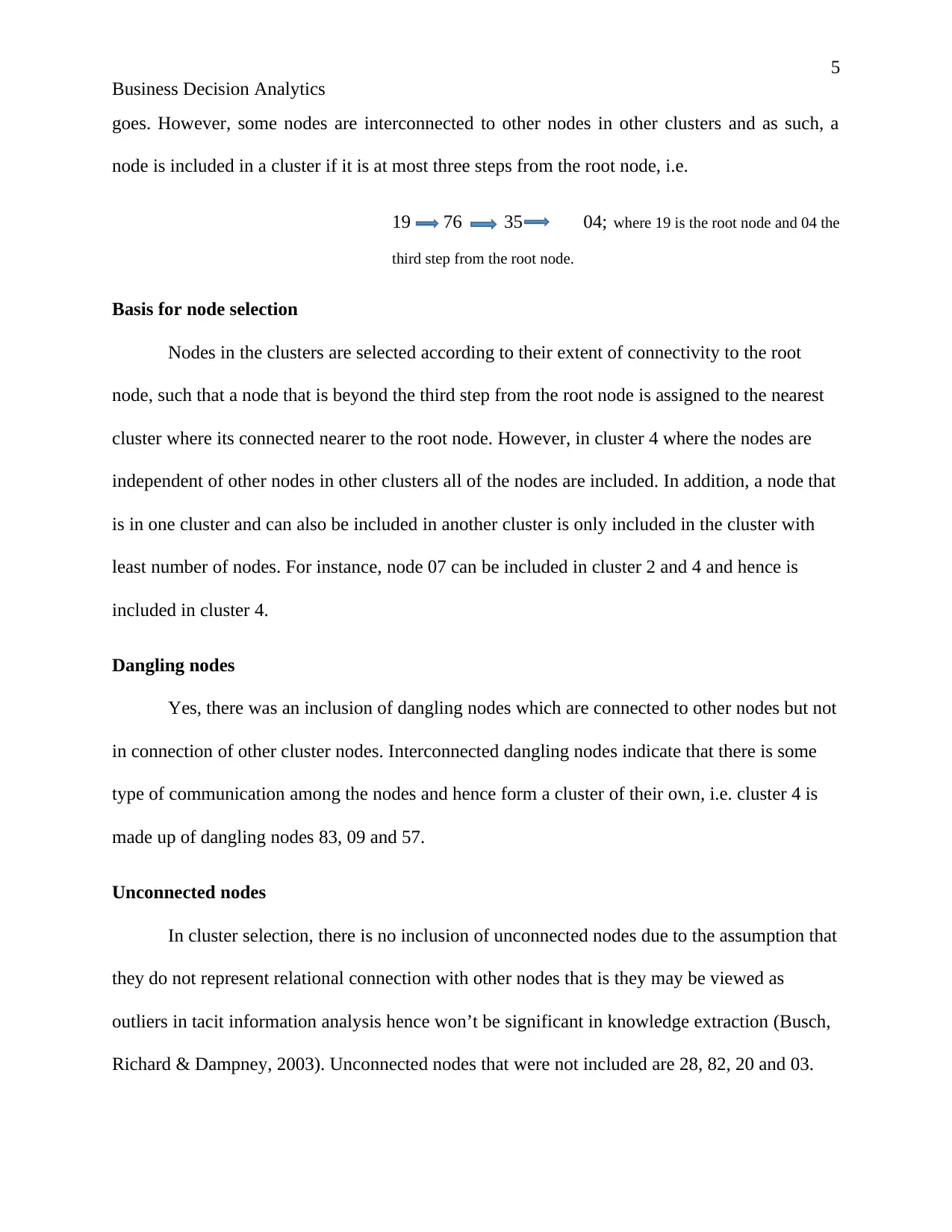
5
Business Decision Analytics
goes. However, some nodes are interconnected to other nodes in other clusters and as such, a
node is included in a cluster if it is at most three steps from the root node, i.e.
19 76 35 04; where 19 is the root node and 04 the
third step from the root node.
Basis for node selection
Nodes in the clusters are selected according to their extent of connectivity to the root
node, such that a node that is beyond the third step from the root node is assigned to the nearest
cluster where its connected nearer to the root node. However, in cluster 4 where the nodes are
independent of other nodes in other clusters all of the nodes are included. In addition, a node that
is in one cluster and can also be included in another cluster is only included in the cluster with
least number of nodes. For instance, node 07 can be included in cluster 2 and 4 and hence is
included in cluster 4.
Dangling nodes
Yes, there was an inclusion of dangling nodes which are connected to other nodes but not
in connection of other cluster nodes. Interconnected dangling nodes indicate that there is some
type of communication among the nodes and hence form a cluster of their own, i.e. cluster 4 is
made up of dangling nodes 83, 09 and 57.
Unconnected nodes
In cluster selection, there is no inclusion of unconnected nodes due to the assumption that
they do not represent relational connection with other nodes that is they may be viewed as
outliers in tacit information analysis hence won’t be significant in knowledge extraction (Busch,
Richard & Dampney, 2003). Unconnected nodes that were not included are 28, 82, 20 and 03.
Business Decision Analytics
goes. However, some nodes are interconnected to other nodes in other clusters and as such, a
node is included in a cluster if it is at most three steps from the root node, i.e.
19 76 35 04; where 19 is the root node and 04 the
third step from the root node.
Basis for node selection
Nodes in the clusters are selected according to their extent of connectivity to the root
node, such that a node that is beyond the third step from the root node is assigned to the nearest
cluster where its connected nearer to the root node. However, in cluster 4 where the nodes are
independent of other nodes in other clusters all of the nodes are included. In addition, a node that
is in one cluster and can also be included in another cluster is only included in the cluster with
least number of nodes. For instance, node 07 can be included in cluster 2 and 4 and hence is
included in cluster 4.
Dangling nodes
Yes, there was an inclusion of dangling nodes which are connected to other nodes but not
in connection of other cluster nodes. Interconnected dangling nodes indicate that there is some
type of communication among the nodes and hence form a cluster of their own, i.e. cluster 4 is
made up of dangling nodes 83, 09 and 57.
Unconnected nodes
In cluster selection, there is no inclusion of unconnected nodes due to the assumption that
they do not represent relational connection with other nodes that is they may be viewed as
outliers in tacit information analysis hence won’t be significant in knowledge extraction (Busch,
Richard & Dampney, 2003). Unconnected nodes that were not included are 28, 82, 20 and 03.
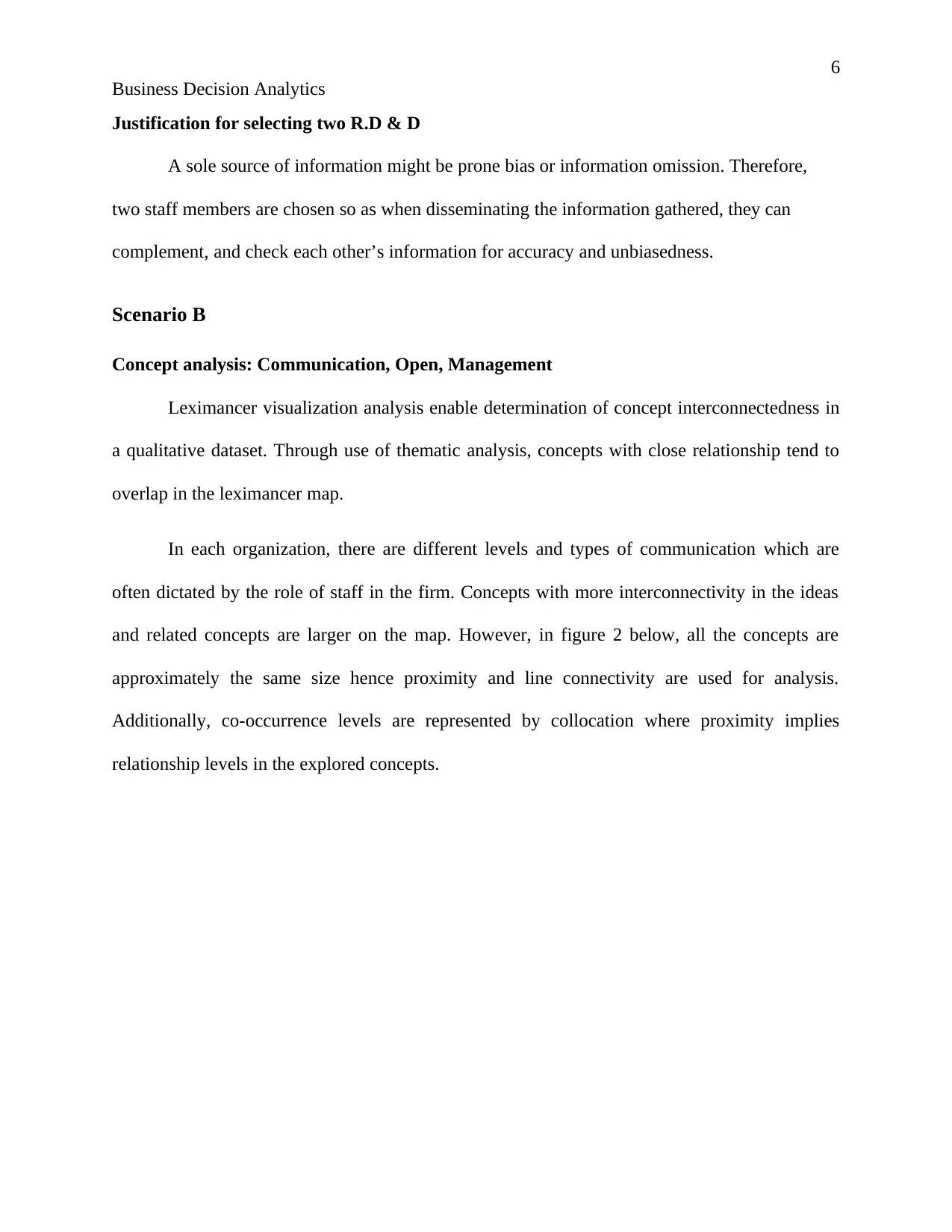
6
Business Decision Analytics
Justification for selecting two R.D & D
A sole source of information might be prone bias or information omission. Therefore,
two staff members are chosen so as when disseminating the information gathered, they can
complement, and check each other’s information for accuracy and unbiasedness.
Scenario B
Concept analysis: Communication, Open, Management
Leximancer visualization analysis enable determination of concept interconnectedness in
a qualitative dataset. Through use of thematic analysis, concepts with close relationship tend to
overlap in the leximancer map.
In each organization, there are different levels and types of communication which are
often dictated by the role of staff in the firm. Concepts with more interconnectivity in the ideas
and related concepts are larger on the map. However, in figure 2 below, all the concepts are
approximately the same size hence proximity and line connectivity are used for analysis.
Additionally, co-occurrence levels are represented by collocation where proximity implies
relationship levels in the explored concepts.
Business Decision Analytics
Justification for selecting two R.D & D
A sole source of information might be prone bias or information omission. Therefore,
two staff members are chosen so as when disseminating the information gathered, they can
complement, and check each other’s information for accuracy and unbiasedness.
Scenario B
Concept analysis: Communication, Open, Management
Leximancer visualization analysis enable determination of concept interconnectedness in
a qualitative dataset. Through use of thematic analysis, concepts with close relationship tend to
overlap in the leximancer map.
In each organization, there are different levels and types of communication which are
often dictated by the role of staff in the firm. Concepts with more interconnectivity in the ideas
and related concepts are larger on the map. However, in figure 2 below, all the concepts are
approximately the same size hence proximity and line connectivity are used for analysis.
Additionally, co-occurrence levels are represented by collocation where proximity implies
relationship levels in the explored concepts.
⊘ This is a preview!⊘
Do you want full access?
Subscribe today to unlock all pages.

Trusted by 1+ million students worldwide
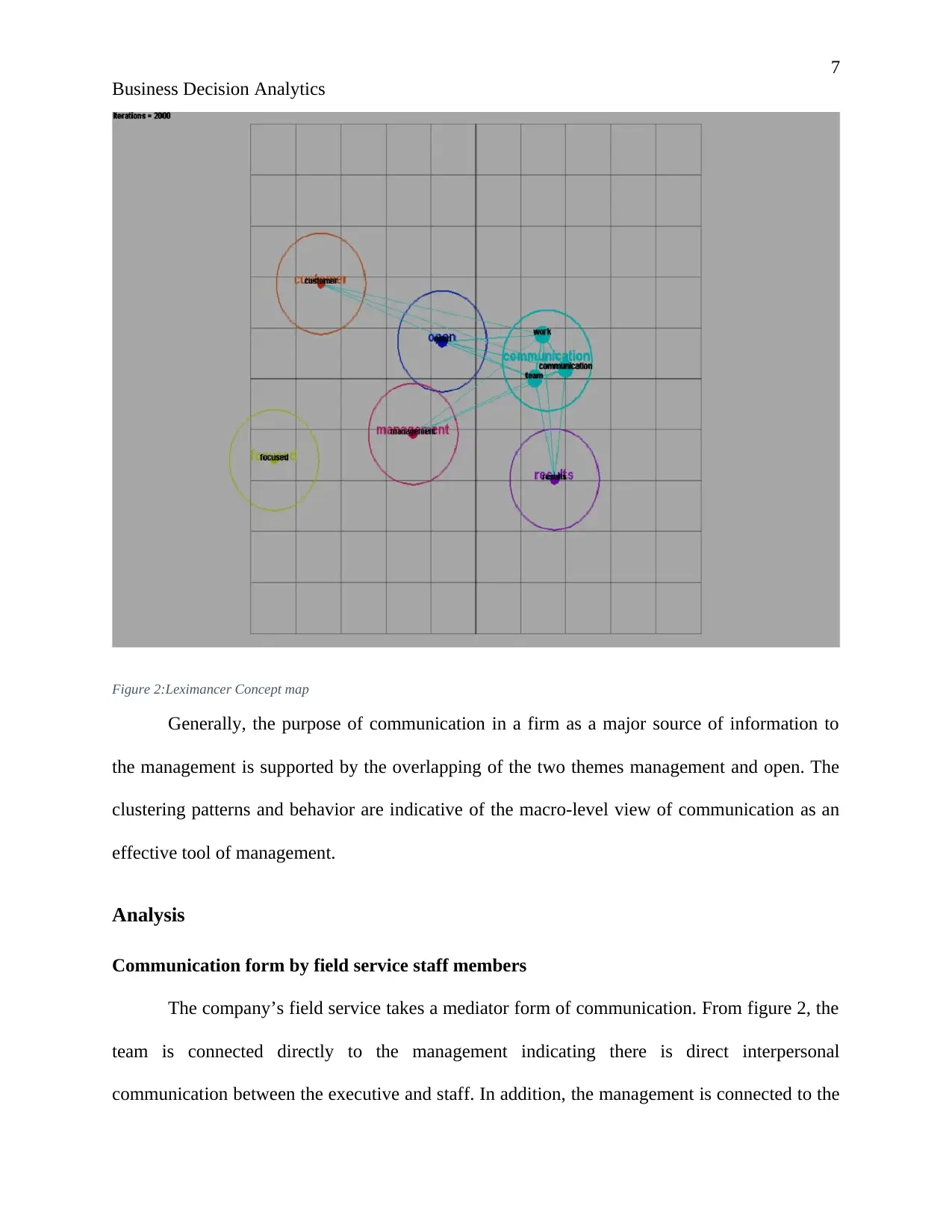
7
Business Decision Analytics
Figure 2:Leximancer Concept map
Generally, the purpose of communication in a firm as a major source of information to
the management is supported by the overlapping of the two themes management and open. The
clustering patterns and behavior are indicative of the macro-level view of communication as an
effective tool of management.
Analysis
Communication form by field service staff members
The company’s field service takes a mediator form of communication. From figure 2, the
team is connected directly to the management indicating there is direct interpersonal
communication between the executive and staff. In addition, the management is connected to the
Business Decision Analytics
Figure 2:Leximancer Concept map
Generally, the purpose of communication in a firm as a major source of information to
the management is supported by the overlapping of the two themes management and open. The
clustering patterns and behavior are indicative of the macro-level view of communication as an
effective tool of management.
Analysis
Communication form by field service staff members
The company’s field service takes a mediator form of communication. From figure 2, the
team is connected directly to the management indicating there is direct interpersonal
communication between the executive and staff. In addition, the management is connected to the
Paraphrase This Document
Need a fresh take? Get an instant paraphrase of this document with our AI Paraphraser
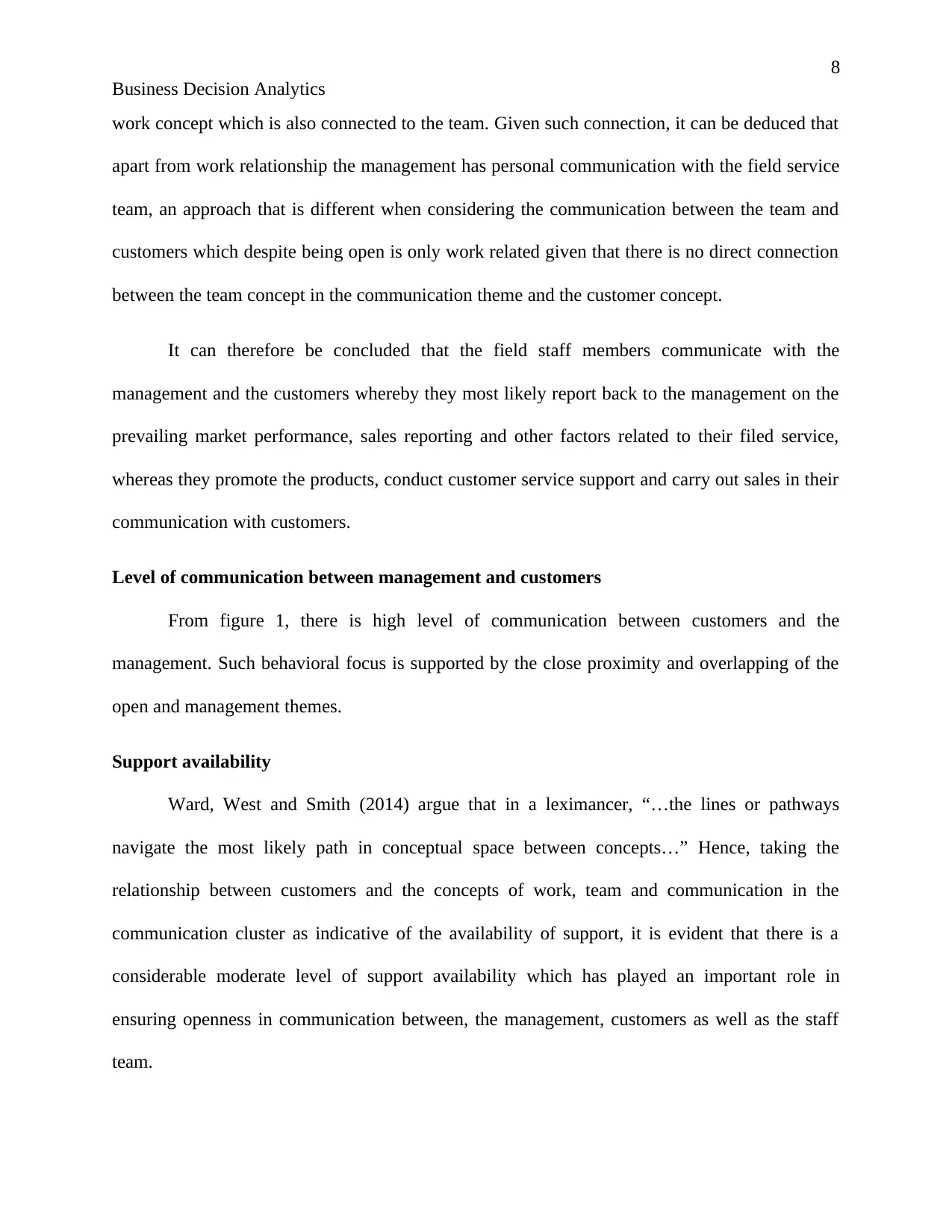
8
Business Decision Analytics
work concept which is also connected to the team. Given such connection, it can be deduced that
apart from work relationship the management has personal communication with the field service
team, an approach that is different when considering the communication between the team and
customers which despite being open is only work related given that there is no direct connection
between the team concept in the communication theme and the customer concept.
It can therefore be concluded that the field staff members communicate with the
management and the customers whereby they most likely report back to the management on the
prevailing market performance, sales reporting and other factors related to their filed service,
whereas they promote the products, conduct customer service support and carry out sales in their
communication with customers.
Level of communication between management and customers
From figure 1, there is high level of communication between customers and the
management. Such behavioral focus is supported by the close proximity and overlapping of the
open and management themes.
Support availability
Ward, West and Smith (2014) argue that in a leximancer, “…the lines or pathways
navigate the most likely path in conceptual space between concepts…” Hence, taking the
relationship between customers and the concepts of work, team and communication in the
communication cluster as indicative of the availability of support, it is evident that there is a
considerable moderate level of support availability which has played an important role in
ensuring openness in communication between, the management, customers as well as the staff
team.
Business Decision Analytics
work concept which is also connected to the team. Given such connection, it can be deduced that
apart from work relationship the management has personal communication with the field service
team, an approach that is different when considering the communication between the team and
customers which despite being open is only work related given that there is no direct connection
between the team concept in the communication theme and the customer concept.
It can therefore be concluded that the field staff members communicate with the
management and the customers whereby they most likely report back to the management on the
prevailing market performance, sales reporting and other factors related to their filed service,
whereas they promote the products, conduct customer service support and carry out sales in their
communication with customers.
Level of communication between management and customers
From figure 1, there is high level of communication between customers and the
management. Such behavioral focus is supported by the close proximity and overlapping of the
open and management themes.
Support availability
Ward, West and Smith (2014) argue that in a leximancer, “…the lines or pathways
navigate the most likely path in conceptual space between concepts…” Hence, taking the
relationship between customers and the concepts of work, team and communication in the
communication cluster as indicative of the availability of support, it is evident that there is a
considerable moderate level of support availability which has played an important role in
ensuring openness in communication between, the management, customers as well as the staff
team.
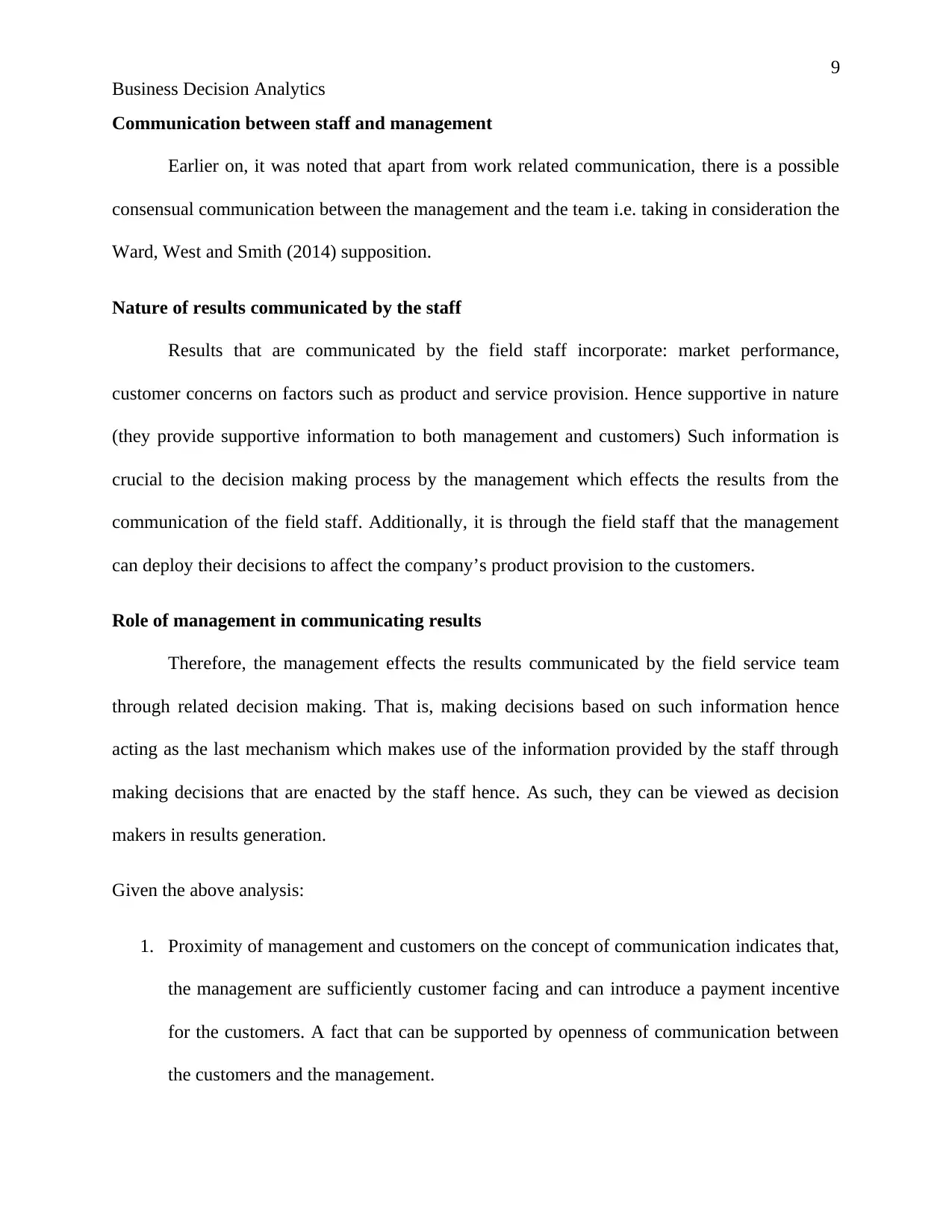
9
Business Decision Analytics
Communication between staff and management
Earlier on, it was noted that apart from work related communication, there is a possible
consensual communication between the management and the team i.e. taking in consideration the
Ward, West and Smith (2014) supposition.
Nature of results communicated by the staff
Results that are communicated by the field staff incorporate: market performance,
customer concerns on factors such as product and service provision. Hence supportive in nature
(they provide supportive information to both management and customers) Such information is
crucial to the decision making process by the management which effects the results from the
communication of the field staff. Additionally, it is through the field staff that the management
can deploy their decisions to affect the company’s product provision to the customers.
Role of management in communicating results
Therefore, the management effects the results communicated by the field service team
through related decision making. That is, making decisions based on such information hence
acting as the last mechanism which makes use of the information provided by the staff through
making decisions that are enacted by the staff hence. As such, they can be viewed as decision
makers in results generation.
Given the above analysis:
1. Proximity of management and customers on the concept of communication indicates that,
the management are sufficiently customer facing and can introduce a payment incentive
for the customers. A fact that can be supported by openness of communication between
the customers and the management.
Business Decision Analytics
Communication between staff and management
Earlier on, it was noted that apart from work related communication, there is a possible
consensual communication between the management and the team i.e. taking in consideration the
Ward, West and Smith (2014) supposition.
Nature of results communicated by the staff
Results that are communicated by the field staff incorporate: market performance,
customer concerns on factors such as product and service provision. Hence supportive in nature
(they provide supportive information to both management and customers) Such information is
crucial to the decision making process by the management which effects the results from the
communication of the field staff. Additionally, it is through the field staff that the management
can deploy their decisions to affect the company’s product provision to the customers.
Role of management in communicating results
Therefore, the management effects the results communicated by the field service team
through related decision making. That is, making decisions based on such information hence
acting as the last mechanism which makes use of the information provided by the staff through
making decisions that are enacted by the staff hence. As such, they can be viewed as decision
makers in results generation.
Given the above analysis:
1. Proximity of management and customers on the concept of communication indicates that,
the management are sufficiently customer facing and can introduce a payment incentive
for the customers. A fact that can be supported by openness of communication between
the customers and the management.
⊘ This is a preview!⊘
Do you want full access?
Subscribe today to unlock all pages.

Trusted by 1+ million students worldwide
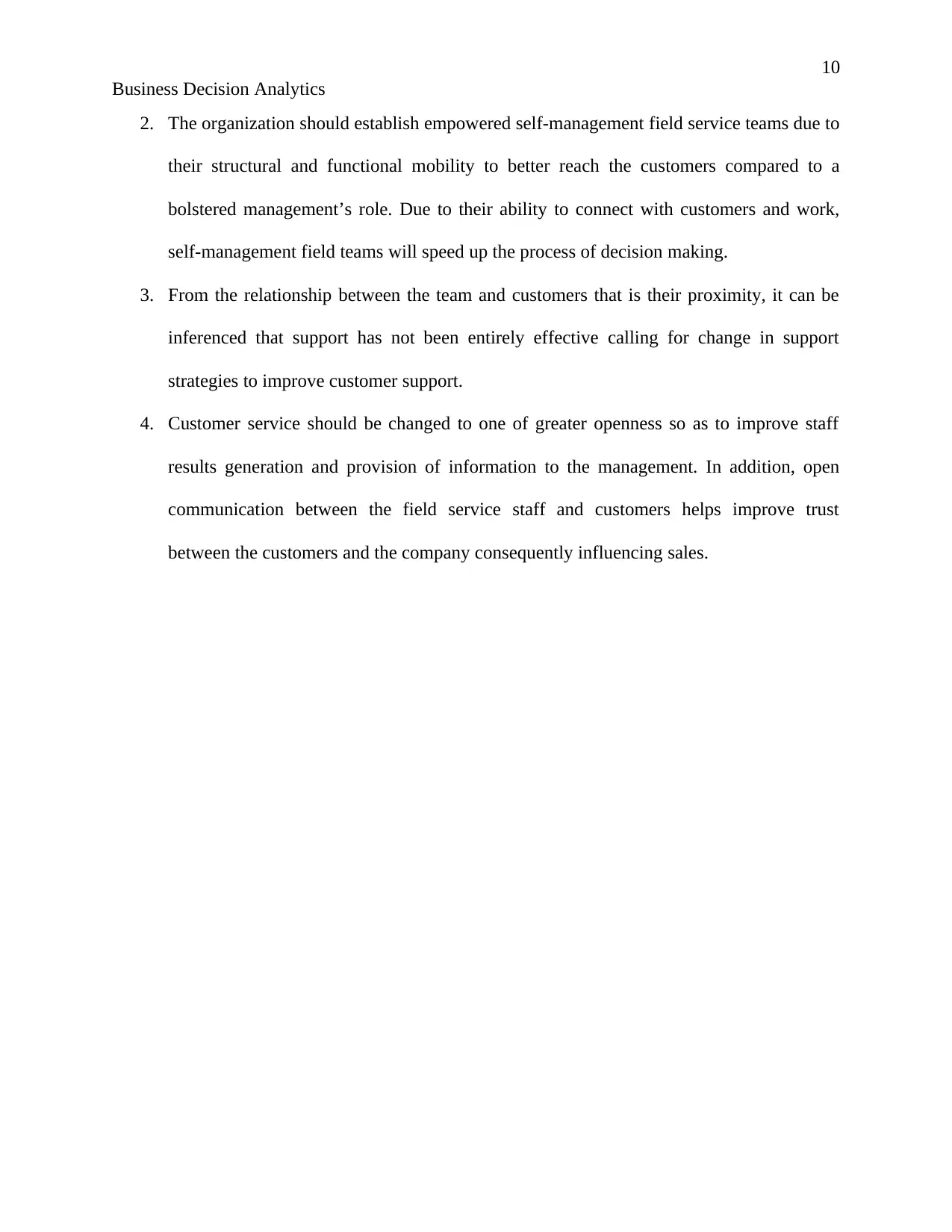
10
Business Decision Analytics
2. The organization should establish empowered self-management field service teams due to
their structural and functional mobility to better reach the customers compared to a
bolstered management’s role. Due to their ability to connect with customers and work,
self-management field teams will speed up the process of decision making.
3. From the relationship between the team and customers that is their proximity, it can be
inferenced that support has not been entirely effective calling for change in support
strategies to improve customer support.
4. Customer service should be changed to one of greater openness so as to improve staff
results generation and provision of information to the management. In addition, open
communication between the field service staff and customers helps improve trust
between the customers and the company consequently influencing sales.
Business Decision Analytics
2. The organization should establish empowered self-management field service teams due to
their structural and functional mobility to better reach the customers compared to a
bolstered management’s role. Due to their ability to connect with customers and work,
self-management field teams will speed up the process of decision making.
3. From the relationship between the team and customers that is their proximity, it can be
inferenced that support has not been entirely effective calling for change in support
strategies to improve customer support.
4. Customer service should be changed to one of greater openness so as to improve staff
results generation and provision of information to the management. In addition, open
communication between the field service staff and customers helps improve trust
between the customers and the company consequently influencing sales.
Paraphrase This Document
Need a fresh take? Get an instant paraphrase of this document with our AI Paraphraser
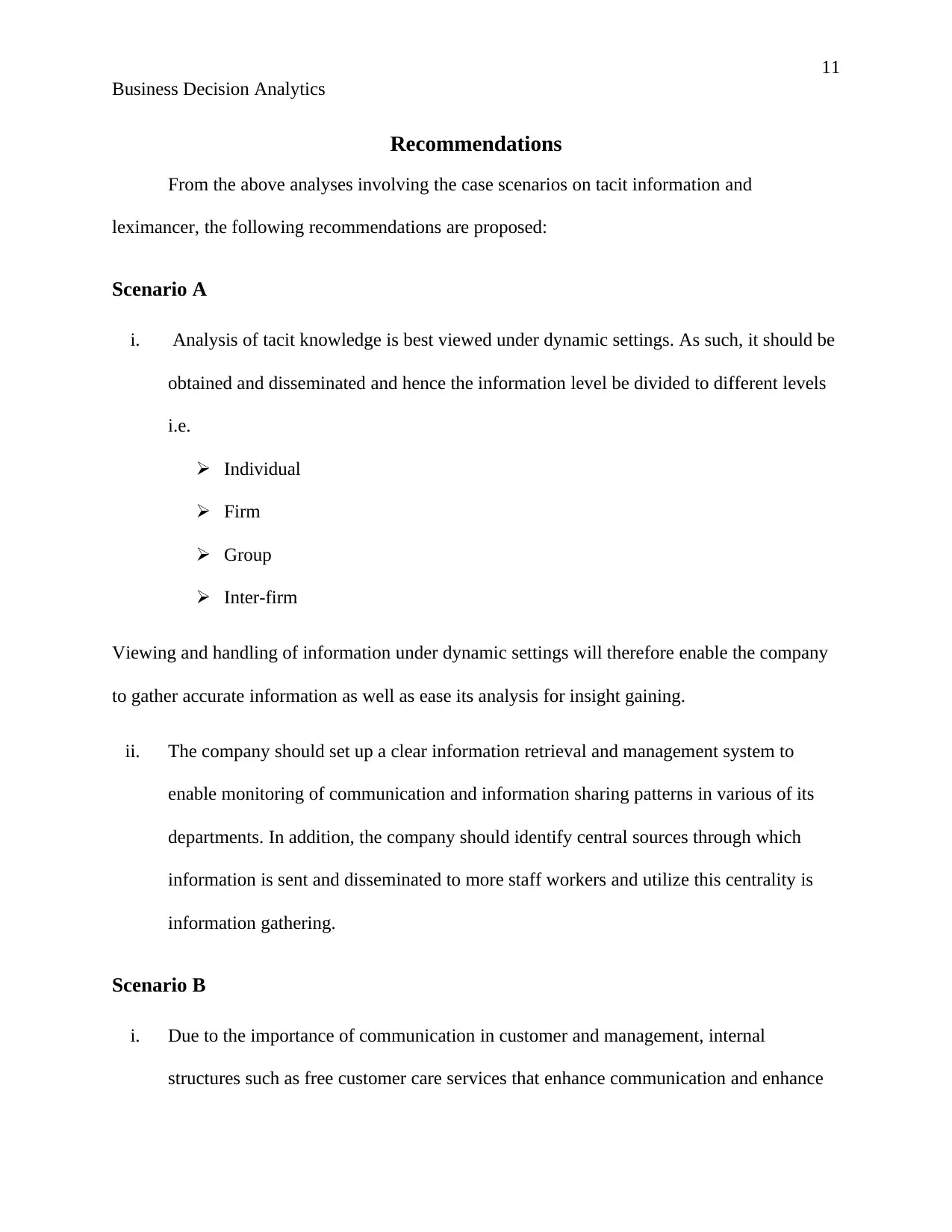
11
Business Decision Analytics
Recommendations
From the above analyses involving the case scenarios on tacit information and
leximancer, the following recommendations are proposed:
Scenario A
i. Analysis of tacit knowledge is best viewed under dynamic settings. As such, it should be
obtained and disseminated and hence the information level be divided to different levels
i.e.
Individual
Firm
Group
Inter-firm
Viewing and handling of information under dynamic settings will therefore enable the company
to gather accurate information as well as ease its analysis for insight gaining.
ii. The company should set up a clear information retrieval and management system to
enable monitoring of communication and information sharing patterns in various of its
departments. In addition, the company should identify central sources through which
information is sent and disseminated to more staff workers and utilize this centrality is
information gathering.
Scenario B
i. Due to the importance of communication in customer and management, internal
structures such as free customer care services that enhance communication and enhance
Business Decision Analytics
Recommendations
From the above analyses involving the case scenarios on tacit information and
leximancer, the following recommendations are proposed:
Scenario A
i. Analysis of tacit knowledge is best viewed under dynamic settings. As such, it should be
obtained and disseminated and hence the information level be divided to different levels
i.e.
Individual
Firm
Group
Inter-firm
Viewing and handling of information under dynamic settings will therefore enable the company
to gather accurate information as well as ease its analysis for insight gaining.
ii. The company should set up a clear information retrieval and management system to
enable monitoring of communication and information sharing patterns in various of its
departments. In addition, the company should identify central sources through which
information is sent and disseminated to more staff workers and utilize this centrality is
information gathering.
Scenario B
i. Due to the importance of communication in customer and management, internal
structures such as free customer care services that enhance communication and enhance
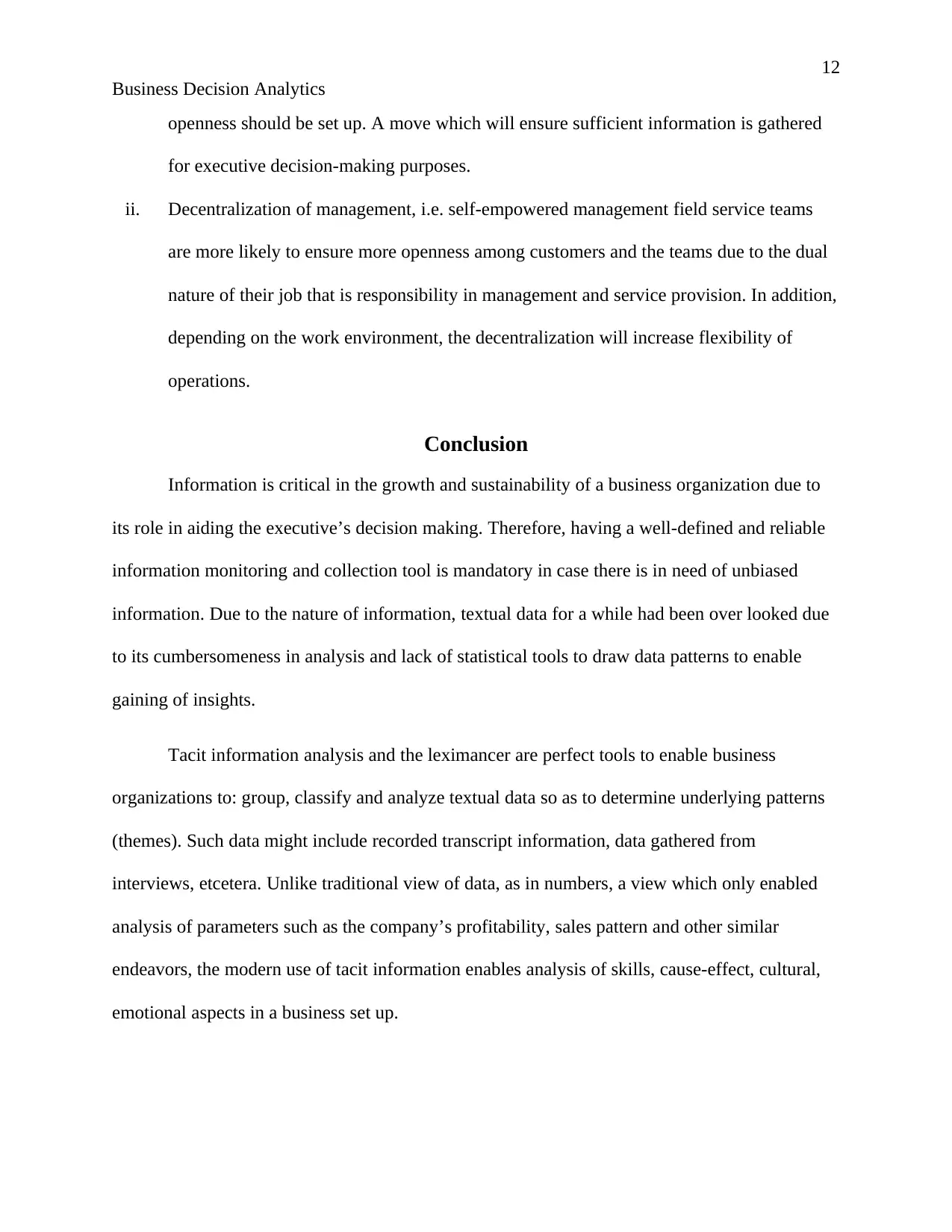
12
Business Decision Analytics
openness should be set up. A move which will ensure sufficient information is gathered
for executive decision-making purposes.
ii. Decentralization of management, i.e. self-empowered management field service teams
are more likely to ensure more openness among customers and the teams due to the dual
nature of their job that is responsibility in management and service provision. In addition,
depending on the work environment, the decentralization will increase flexibility of
operations.
Conclusion
Information is critical in the growth and sustainability of a business organization due to
its role in aiding the executive’s decision making. Therefore, having a well-defined and reliable
information monitoring and collection tool is mandatory in case there is in need of unbiased
information. Due to the nature of information, textual data for a while had been over looked due
to its cumbersomeness in analysis and lack of statistical tools to draw data patterns to enable
gaining of insights.
Tacit information analysis and the leximancer are perfect tools to enable business
organizations to: group, classify and analyze textual data so as to determine underlying patterns
(themes). Such data might include recorded transcript information, data gathered from
interviews, etcetera. Unlike traditional view of data, as in numbers, a view which only enabled
analysis of parameters such as the company’s profitability, sales pattern and other similar
endeavors, the modern use of tacit information enables analysis of skills, cause-effect, cultural,
emotional aspects in a business set up.
Business Decision Analytics
openness should be set up. A move which will ensure sufficient information is gathered
for executive decision-making purposes.
ii. Decentralization of management, i.e. self-empowered management field service teams
are more likely to ensure more openness among customers and the teams due to the dual
nature of their job that is responsibility in management and service provision. In addition,
depending on the work environment, the decentralization will increase flexibility of
operations.
Conclusion
Information is critical in the growth and sustainability of a business organization due to
its role in aiding the executive’s decision making. Therefore, having a well-defined and reliable
information monitoring and collection tool is mandatory in case there is in need of unbiased
information. Due to the nature of information, textual data for a while had been over looked due
to its cumbersomeness in analysis and lack of statistical tools to draw data patterns to enable
gaining of insights.
Tacit information analysis and the leximancer are perfect tools to enable business
organizations to: group, classify and analyze textual data so as to determine underlying patterns
(themes). Such data might include recorded transcript information, data gathered from
interviews, etcetera. Unlike traditional view of data, as in numbers, a view which only enabled
analysis of parameters such as the company’s profitability, sales pattern and other similar
endeavors, the modern use of tacit information enables analysis of skills, cause-effect, cultural,
emotional aspects in a business set up.
⊘ This is a preview!⊘
Do you want full access?
Subscribe today to unlock all pages.

Trusted by 1+ million students worldwide
1 out of 14
Related Documents
Your All-in-One AI-Powered Toolkit for Academic Success.
+13062052269
info@desklib.com
Available 24*7 on WhatsApp / Email
![[object Object]](/_next/static/media/star-bottom.7253800d.svg)
Unlock your academic potential
Copyright © 2020–2025 A2Z Services. All Rights Reserved. Developed and managed by ZUCOL.




